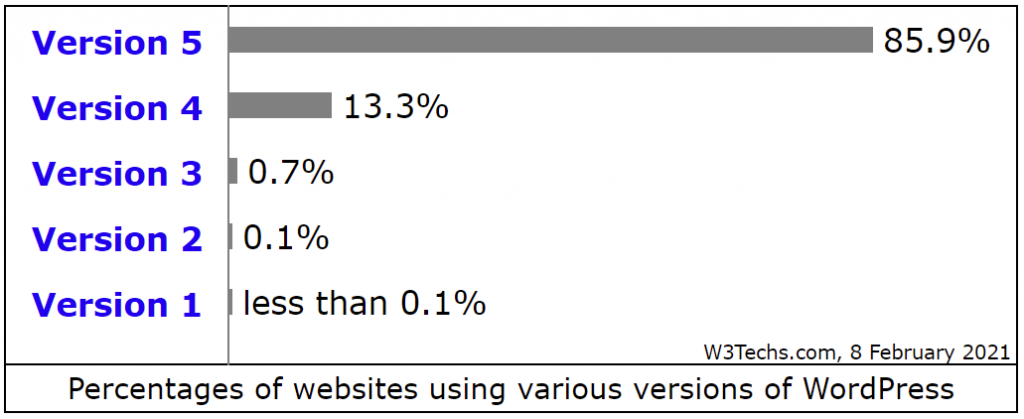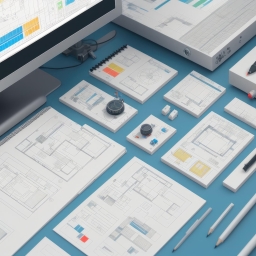
30 Valuable Web Design Statistics for 2021
How many website users are there in the world? And how many online websites are there to serve those users? Find answers to these and other interesting questions regarding web statistics and use this information to create better websites.
As a web designer, there’s much you need to do to stay at the top of your game and ahead of your competitors.
You need to keep up with current web design trends to know what the face of the web currently looks like and to successfully design websites for today’s consumers and businesses.
You also need to broaden your knowledge of and improve your skills by reading web design books, learning from the latest tutorials, and taking courses. Another important thing you need to do is to keep your eye on the latest data and research in the field of web design.
There are tons of organizations and publications committed to researching and reporting on the efficacy of web design as well as consumers’ responses to it. Pay close enough attention to these web design statistics and you’ll find it much easier to create user-centric websites.
This will be our focus in today’s article as it’s not always easy to stay abreast of the latest research when it’s coming from so many different sources. Below, we’ve rounded up 30 web design statistics — from Adobe to Google and everyone in between — to see what the movers and shakers have to say about the state of the web in 2021 and beyond.
30 Astonishing Web Design Statistics for 2021
First, let’s check out some statistics we believe reveal a lot about what’s happening online today and why the role of the web designer is so critical:
Web Design Statistics: Editor’s Choice
1. There are more than 4.8 billion Internet users. (Internet Live Stats)
As this number steadily grows, day by day, it’s not just due to more consumers using the Internet. It’s also because there are more businesses flocking to the web to get in front of them.
And who’s going to help those businesses put their best (digital) face forward? That’s right: web designers.
Now is the time to get your web design business up and running if you haven’t already.
2. There are over 1.8 billion websites online. (Internet Live Stats)
If you watch the ticker go, you’ll see that a new website goes live approximately every second. As a result, there’s a growing demand for web designers.
Here are some ways to find that next awesome web design project.
3. There are more than 89,000 Google searches done every second of every day. (Internet Live Stats)
Even though there’s a ton of competition on the web, the sheer number of search queries gives websites a fighting chance to rank — so long as they’re well-optimized for search.
If SEO isn’t yet a part of your web design strategy, it needs to be.
4. Consumers spend, on average, 6 hours and 55 minutes on the Internet every day. (We Are Social/Hootsuite)
Whether they’re at work, at home, on holiday, or on the go, people are finding reasons to be online.
So, don’t worry about there not being enough opportunities for you or even having to settle for a niche you’re less than thrilled about. There’s more than enough to go around.
5. 61% of consumers plan on spending more time online post-pandemic than they did before it. (Salesforce)
It doesn’t appear that the uptick in online activity from 2020 is going to be a temporary thing. A growing number of consumers and businesses have grown quite comfortable in the digital world.
6. 68% of consumers say that they have much higher expectations for businesses’ digital capabilities in the wake of COVID-19. (Salesforce)
While that might get you thinking about new technologies to experiment with (like augmented reality), make sure you’re nailing the basics first. Without a solid foundation for your website, it won’t matter how much flare you add to it.
Website and Web Design Statistics
7. 40% of all websites run on WordPress. (W3Techs)
WordPress continues its dominance over the CMS market share. And with good reason.
If you’re new to web design, WordPress is a great CMS to specialize in. It’s very popular, it’s powerful and you’ll have the freedom to build websites any way you want.
8. 85% of B2B and 79% of B2C users say the experience they have with a brand is just as important as the quality of what it sells. (Salesforce)
While this can apply to all parts of the user experience, the website is likely going to be the first experience most people have with a brand.
In order to empower your clients to make the right first impression with visitors and prospective users, you’ll have to design a superior website experience every time.
If you take a look around the web for inspiration, you’ll get a good idea of what that looks like.
9. 66% of customers want brands to understand their needs and exceed their expectations. (Salesforce)
In other words, there’s more to building a website than just making it look attractive. With a good amount of research, planning, and user persona development, you can ensure that you design the very best experience for the kinds of users your website targets.
10. On average, 69% of website content is never seen by visitors. (ContentSquare)
This is something web designers should be very cognizant of.
It either signals that there’s something wrong with the navigation being too cluttered or disorganized or that too much irrelevant content is being created in the first place. With careful planning upfront, you can create more useful and easily navigable websites.
11. 65% of B2B and 71% of B2C users say that convenience is more important than which brand they buy from. (Salesforce)
With so many options at their disposal, it’s no surprise that consumers don’t have much loyalty to brands. But that doesn’t mean you should give up trying to win them back to the site.
By designing a website that’s fast to load, easy to navigate, and provides the exact solution or answer at the right time, you’ll convince more visitors to return and convert.
12. 68% of consumers want brands to be empathetic. (Salesforce)
This was something that, at one time, UX designers were mainly concerned with. These days, though, consumers want every website to anticipate how they feel, understand their pain, and swiftly deliver the perfect solution for it.
Mobile Web Design Statistics
13. There are 5.2 billion smartphone users around the world. (We Are Social/Hootsuite)
As more and more people get smartphones, websites need to be prepared to deliver a mobile-first experience for these users.
Thankfully, this is easy to do with WordPress. Whether you build your websites with a responsive WordPress theme or a page builder plugin like Elementor, you’re going to provide your mobile visitors with a great experience.
14. Over 50% of all website traffic comes from smartphones. (Statista)
It’s not just the number of smartphones in the world that’s growing. It’s also the usage of smartphones to access websites. So, you need to be ready for it by making responsive design a primary part of your design strategy.
15. It’s predicted that mCommerce will account for 75% of all digital commerce sales by 2023. (Deloitte)
It’s only natural that more smartphone traffic will lead to more website sales on mobile. But this prediction suggests that the number of smartphone sales is going to double between 2019 and 2023.
If that’s the case, then web designers would do well to focus on perfecting the mobile ecommerce experience — from point of entry to checkout.
16. 77% of smartphone shoppers are more likely to convert when they can make a fast purchase. (Think with Google)
One way to help increase your website’s mobile sales is to streamline the shopping process.
You can do this by focusing on improving website components like navigation, product category filters, product page design, and so on.
17. 66% of customers will use multiple devices to begin and complete an online transaction. (Salesforce)
Mobile web design isn’t just about creating a great experience when people visit your site from a smartphone. It’s about creating a consistent experience across all their devices and seamlessly connecting each of these channels together.
Ecommerce and Conversion Rate Statistics
18. There are 5 common factors that drive people to buy something online. (Think with Google)
The most popular one is having the cheapest prices, so providing shoppers with a price comparison tool would be advantageous.
Free shipping, sales/discounts, product availability, and product specs round out the top five. These features are easy enough to include in a website — just make sure they’re easy to find.
19. On average, it takes users 3 sessions to convert. (ContentSquare)
With some industries, it takes longer (like luxury brands) while others shorter (like financial services).
Regardless of how long it takes your visitors to convert, your website is going to need a way to stay top-of-mind with these visitors while they mull their decision over.
Subscription forms, free giveaways, and emails in exchange for coupon codes are a good way to establish this, so make these lead-generating tactics part of your web design strategy.
20. 8.95% of mobile users add items to their carts as opposed to 4.35% of desktop users. (Monetate)
While this could be indicative of mobile ecommerce sites providing a better shopping experience, you’ll need to consider this web design statistic in conjunction with the next one.
21. 1.81% of mobile users convert as opposed to 1.98% of desktop users. (Monetate)
There’s something clearly holding mobile shoppers back. Part of this is likely due to security concerns with mobile, but the mobile checkout experience could be problematic as well (especially if you use an out-of-the-box payment gateway solution).
So, make sure you consider all angles of this as you design any m-commerce experience.
Website Security Statistics
22. Web designers recognize the grave consequences of a hacked website. (Sucuri)
59% believe that the biggest impact on a brand is the time they lose dealing with a hacked website.
In addition, 27% have seen brands lose revenue, 26.4% experienced a loss in customer confidence and 25.6% saw a damaged reputation as a result of a security breach.
23. Over 94% of CMS website infections in 2019 were on WordPress websites. (Sucuri)
Part of the reason why WordPress websites seem to be so susceptible to attack is because of the sheer popularity of the CMS. However, there are other reasons why WordPress always tops the list of hacked website reports.
When core WordPress, plugin, and theme updates aren’t implemented in a timely fashion (or at all), any potential software vulnerabilities can leave websites open to attack.
One thing you can do as a designer is to enable automatic updates, when possible. A better option, though, would be to offer monthly maintenance services where you manage these updates (as well as things like security and uptime monitoring) for your clients.
24. 63% of consumers believe that most companies aren’t being open or honest about how they use their data. (Salesforce)
It’s not just website security you have to be cognizant of. You also need to look at this from the data privacy side as well.
While you definitely want to keep your clients’ customers from getting their data stolen by hackers, you also need to make them aware of what you’re doing with the data in the first place.
Having an easy-to-find privacy policy page is a good place to start as is a cookie consent and approval bar at the bottom of your site.
If visitors know why you need their data and what will happen with it, they’ll feel calmer and more confident when it comes time to convert. Even better, give them control over which cookies you use.
Website Speed Statistics
25. With a 20% increase in page loading times, visitors view 20% fewer pages. (ContentSquare)
We’re all familiar with the statistic about the majority of people abandoning a website if it takes more than 3 seconds to load. But it’s not just abandonment you should worry about.
When you make visitors wait around for each painstakingly slow page to load, you’re essentially encouraging them to see less of the site. This can have negative consequences.
For instance, if they get frustrated with looking at products, they might settle for one that was okay, only to return it later. (Returns and refunds are very costly for brands, so your client wouldn’t be too happy about this). So, make sure your site is optimized for speed.
26. A 0.1-second increase in load time can significantly improve a website’s performance. (Deloitte)
This study observed websites across a wide range of industries. A 0.1-second improvement in loading speeds resulted in a whole host of benefits:
- 8% to 10% more conversions
- 10% more money spent
- 7% to 8% more pages viewed
- Product page bounce rates improved by 5%
- Ecommerce customer engagement increased by 5%
27. All it takes is 1 second for users to lose focus on the task they’re in the middle of. 10 seconds will cause them to give up on it entirely. (Deloitte/Google)
You design websites to be attractive and your calls-to-action eye-catching. But a slow-loading page will keep visitors from seeing any of that right away.
Slow-loading websites are easy enough to take care of as web designers.
Caching should be your best friend as should image optimization. And don’t forget that the more “stuff” you put on each page, the heavier it’s going to be and the longer it will take to load. So, minimalist design is key.
2020 and Its Impact on Web Designers
28. 90% of web designers believe that trends in visual culture are evolving faster than ever before. (Adobe)
As a result of the various crises of 2020, the web had to change — FAST.
Web designers now have to take into account how additional external forces and events may impact the way consumers use the web and how businesses present their offerings to them. This, in turn, means approaching web design in different ways.
29. 82% of designers said that 2020 has changed how they create going forward. (Adobe)
It seemed like there was one disruption after another in 2020. As a result, brands needed to be ready to pivot at a moment’s notice so as not to lose momentum or fall behind the pack.
Web designers, in turn, had to become masters of agility so that they too could change course on a moment’s notice.
30. 83% of web designers believe that now, more than ever, it’s important to expand their skill sets. (Adobe)
While there will always be a need for web designers, there’s no guarantee that you can keep doing “business as usual”.
Take web designers who worked for the restaurant industry, for instance. With so many restaurants going out of business, designers who once specialized in that space have likely had to make a name for themselves in a new niche or learn how to design a different type of restaurant website (e.g. one with curbside pickup ordering as opposed to dine-in reservations).
The Importance of Web Design Is Clear
When you look at these web design statistics, what’s the overall message you take away from them? To us, it’s that web design is an incredibly valuable skill and one that will never go out of fashion.
However, the web is always evolving and web designers need to be prepared to keep up with it.
By always working to sharpen your existing web design and business management skills, as well as acquiring new ones, you’ll find that these kinds of disruptions can’t affect you too much.






















